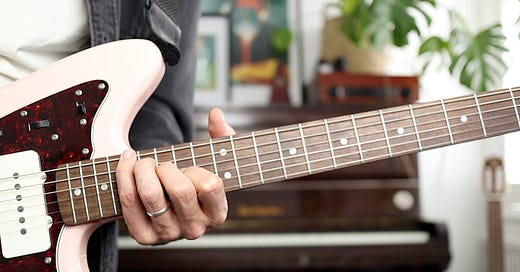Hey guitar players,
A big happy new year! I hope 2025 has started well for you ❤️
One of the main ways to improve on guitar (or anything) - is to have a schedule/routine that you commit to.
Something that helps to hold yourself accountable 👈
Here is a suggested practice routine that will help build your musical confidence and creativity 👇
* I will also link a PDF at the end of this newsletter that showcases a wide variety of exercises to improve your finger strength, stretch & independence
SCHEDULE
(Daily.. when possible…)
The below durations are only suggested. Adjust these to suit your availability. They can be flexible and vary each time you practice. And you can experiment with the order of sections (if you wish) - But try to remain consistent with the content.
💪 WARM UP: 5 - 10 Minutes
Stretching exercises. Like this (try it on every string) 👇
Technique development with chromatic exercises that work on finger strength, stretch & independence. Like these (again.. mix up what strings you play) 👇
Then, try to reverse the pattern.
It’s important to vary the structure and order of exercises. Don’t get stuck in the habit of just playing the same ones in the same positions on the neck every day. This could place you in a comfort zone - when actually, you want to be looking at continually adding little challenges and variants to your playing.
This timeframe could also be used to develop techniques such as ‘hammer-ons’ and ‘pull-offs’. Incorporate them in to the exercises you are playing.
🎶 SONG DEVELOPMENT: 10 - 15 Minutes
Now your fingers are warmed up, you can introduce any songs you are working on.
Begin by playing through progressions/songs you are familiar with.
Once the notes and movements for your current batch of songs are being played well - then look to add more diverse music to your repertoire, that gradually challenge your ability
🎸 LEAD WORK: 10 - 15 Minutes
Practice lead melodies you are working on or like the sound of. Take sections from the songs you love and see if they can be performed on the guitar. If the song doesn’t include definitive lead guitar parts, then research the vocal, keyboard etc, and see if these lead lines can be transposed to Guitar.
Take a step back from the fun of working through your favourite songs - and spend some time getting your technique progressing again by introducing some scale work.
If you are working on a particular scale shape, be mindful that you do not just want to play this in the same position every day. Move this shape up and down the fretboard, so that your fingers are used to new positions. This way, you are training your brain to become more familiar with the fretboard.
On some days, you could use this time to work on music theory. If there are topics you are unsure of, utilise this time for research and ways you can practically implement what you are learning (my beginner guitar course offers an accessible route into music theory)
🖐️ FINGERPICKING: 10 - 15 minutes (This section is more of an optional one. Not everyone is keen to learn finger style. But, it’s a great technique to develop. So, maybe keep it in mind, as something you could begin to experiment with)
Your fingers will be nice and warmed up now, so challenge them by introducing fingerpicking.
You could take chord progressions you are comfortable with and begin to fingerpick between them.
If a song you are learning has a designated strumming pattern, but no fingerpicking, see if you can find a fingerpicking pattern that works over this progression
Experiment with different time signatures and picking patterns. 4/4 & 6/8 are very common, so become familiar with these first. Apply them over different chord progressions. And then start to research more advanced timings. To aid with this, you can introduce a metronome. As you begin to gradually increase the tempo, it will help enhance your speed and accuracy (Get 1 months free access to my beginner fingerpicking course here)
✨ CREATIVE EXPRESSION: 10 - 15 Minutes
A section that I believe is very important!
Don’t set yourself too may boundaries or parameters
Utilise this time to jam along to your favourite songs. Try to create your own lead parts around what you can already hear.
Use this time for ear training. Put some music on and see if you can work out the root notes, chords, or lead parts being played. Once you have done this, you could then check the tab online, or YouTube tutorials to see what you got correct and what you need to change.
Discover your own creative voice! Attempt to write your own chord progressions. Chop up, reverse or completely change the order of chord progressions you already know, and turn them in to your own.
And… attempt to come up with something completely from scratch. By doing this, you are composing your own music!
** At all times, I believe it’s important to keep your practice varied. Even a slight and subtle change to the position you practice on the neck, will greatly aid your overall playing ability and awareness of the fretboard 👌
** The above timeframes are just guidelines. I fully appreciate that this amount of time is not always available in peoples lives! Even if you can tackle one section, or are just managing 2 or 3 minutes for each part - this is still aiding your development 💯
Take This Further
Head here to access your free PDF, that contains a wide mix of finger exercises. You will also find a document that demonstrates how to implement hammer-ons and pull-offs into your practice
I’ll catch up with you again soon.
Marc
x
🌍 Links
🎸 Learn Guitar: The Complete Beginners Guide
🙋♂️Follow me:
🧡 My Music Charity








